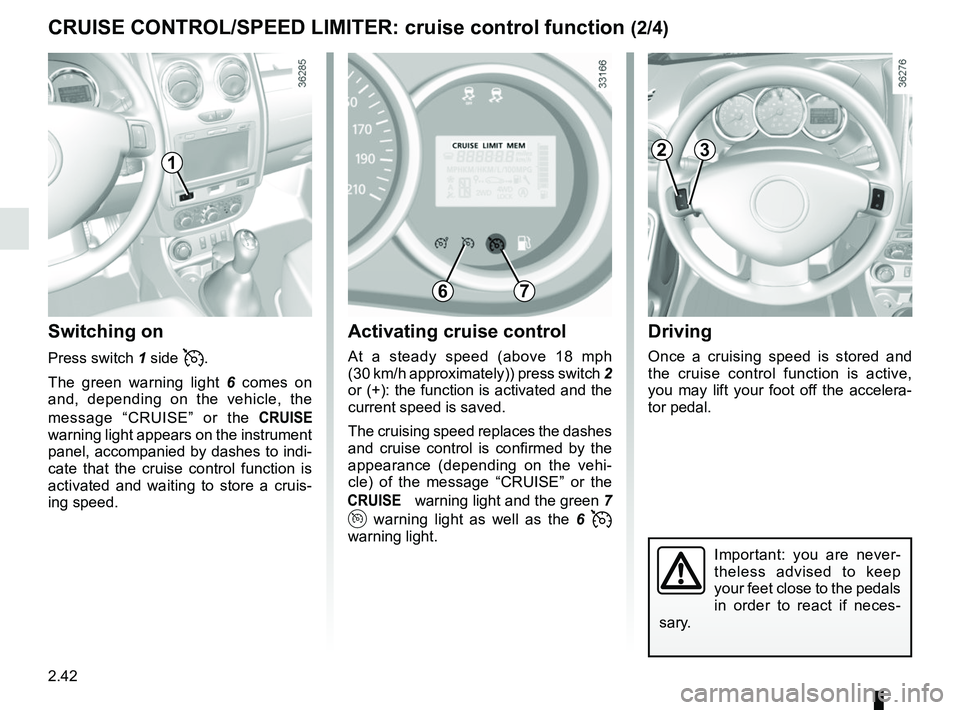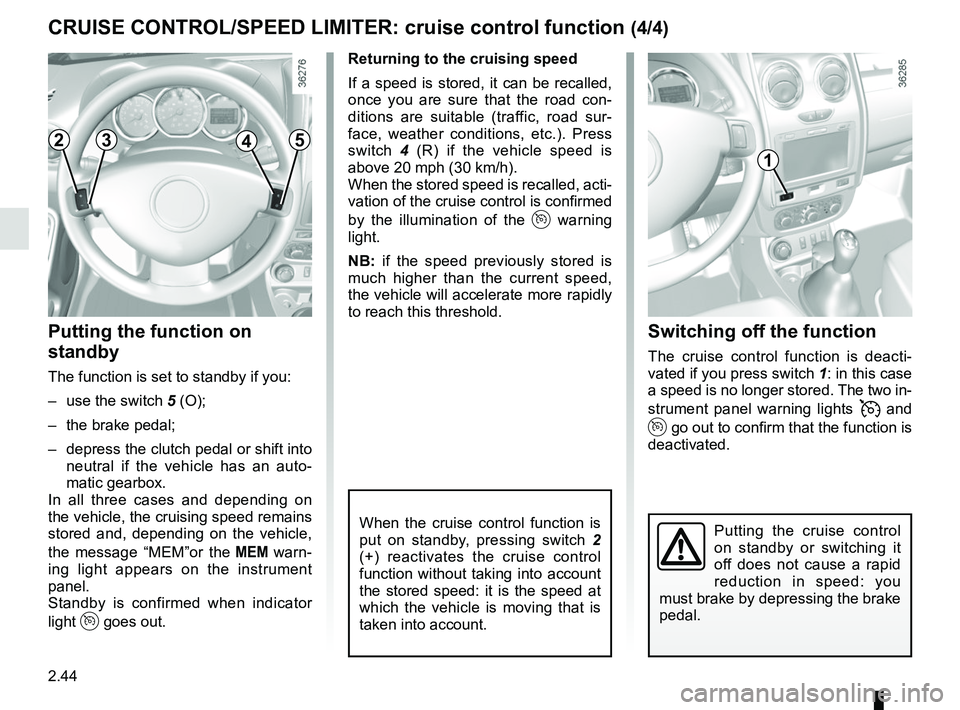Page 114 of 256
2.38
Switching on
Press switch 1 on the side showing .
The warning light 6 is orange and, de-
pending on the vehicle, the message
“LIMIT” or the warning light
ap-
pears on the instrument panel, accom-
panied by dashes to indicate that the
speed limiter function is activated and
waiting to memorise a limit speed.
To store the current speed, press
switch 2 (+): the limit speed will replace
the dashes.
The minimum stored speed is 20 mph
(30 km/h).
Controls
1 Main “On/Off” switch.
2 Limit speed activation, storage and increase switch (+).
3 Decreasing the limit speed (-).
4 Activation and recall of memorised limit speed (R).
5 Speed limiter function standby (with limited speed memory) (O).
The speed limiter function helps you
stay within the driving speed limit that
you choose, known as the
limit speed.
CRUISE CONTROL/SPEED LIMITER: speed limiter function (1/3)
6
12345
Page 116 of 256
2.40
CRUISE CONTROL/SPEED LIMITER: speed limiter function (3/3)
Recalling the limit speed
If a speed has been saved, it can be re-
called by pressing switch 4 ((R)).
Putting the function on
standby
The speed limiter function is suspended
when you press the switch 5 (O). In this
case, the speed limit remains stored
and, depending on the vehicle, the
message "MEM” or the warning light
appears on the instrument panel,
accompanied by the stored speed.
Switching off the function
The speed limiter function is deac-
tivated if you press switch 1 : in this
case a speed is no longer stored. The
orange instrument panel warning light
goes out, confirming that the func-
tion is stopped.
When the speed limiter is put on
standby, pressing switch 2 (+) re-
activates the function without taking
into account the stored speed: it is
the speed at which the vehicle is
moving that is taken into account.
12345
Page 118 of 256

2.42
Driving
Once a cruising speed is stored and
the cruise control function is active,
you may lift your foot off the accelera-
tor pedal.
Important: you are never-
theless advised to keep
your feet close to the pedals
in order to react if neces-
sary.
Activating cruise control
At a steady speed (above 18 mph
(30 km/h approximately)) press switch 2
or (+): the function is activated and the
current speed is saved.
The cruising speed replaces the dashes
and cruise control is confirmed by the
appearance (depending on the vehi-
cle) of the message “CRUISE” or the
warning light and the green 7
warning light as well as the 6
warning light.
Switching on
Press switch 1 side .
The green warning light 6 comes on
and, depending on the vehicle, the
message “CRUISE” or the
warning light appears on the instrument
panel, accompanied by dashes to indi-
cate that the cruise control function is
activated and waiting to store a cruis-
ing speed.
CRUISE CONTROL/SPEED LIMITER: cruise control function (2/4)
1
6
23
7
Page 120 of 256

2.44
Switching off the function
The cruise control function is deacti-
vated if you press switch 1: in this case
a speed is no longer stored. The two in-
strument panel warning lights
and
go out to confirm that the function is
deactivated.
Returning to the cruising speed
If a speed is stored, it can be recalled,
once you are sure that the road con-
ditions are suitable (traffic, road sur-
face, weather conditions, etc.). Press
switch
4 (R) if the vehicle speed is
above 20 mph (30 km/h).
When the stored speed is recalled, acti-
vation of the cruise control is confirmed
by the illumination of the
warning
light.
NB: if the speed previously stored is
much higher than the current speed,
the vehicle will accelerate more rapidly
to reach this threshold.
When the cruise control function is
put on standby, pressing switch 2
(+) reactivates the cruise control
function without taking into account
the stored speed: it is the speed at
which the vehicle is moving that is
taken into account.
Putting the function on
standby
The function is set to standby if you:
– use the switch 5 (O);
– the brake pedal;
– depress the clutch pedal or shift into neutral if the vehicle has an auto-
matic gearbox.
In all three cases and depending on
the vehicle, the cruising speed remains
stored and, depending on the vehicle,
the message “MEM”or the
warn-
ing light appears on the instrument
panel.
Standby is confirmed when indicator
light
goes out.
CRUISE CONTROL/SPEED LIMITER: cruise control function (4/4)
Putting the cruise control
on standby or switching it
off does not cause a rapid
reduction in speed: you
must brake by depressing the brake
pedal.
2345
1
Page 122 of 256

2.46
AUTOMATIC GEARBOX (2/4)
Driving in manual modeWhen the selector lever is in position D,
move the lever to the left.
Shifting the lever repeatedly allows you
to change gears manually:
– To move down through the gears, push the lever backwards;
– to move up through the gears, push the lever forwards.
Depending on the vehicle:
– to move down through the gears, push the lever forwards; – to move up through the gears, push
the lever backwards.
The gear selected is displayed on the
instrument panel.
Special cases
In certain driving conditions (e.g.: to
protect the engine) the “automated
system” may change the gear automa-
tically.
Likewise, to prevent incorrect ma-
noeuvres, a gear change may be re-
fused by the automatic system: in this
case the gear display flashes for a few
seconds as a warning.
Economical driving
When driving, always leave the lever
in position D, keeping the accelerator
pedal lightly depressed to ensure auto-
matic gear changes at a lower engine
speed.
Accelerating and overtaking
Depress the accelerator pedal firmly
and fully (so that it goes beyond the
kickdown point).
This will enable you to change down
to the optimum gear within the
engine range.
Page 123 of 256

2.47
AUTOMATIC GEARBOX (3/4)
Special circumstances
– Depending on the vehicle, snow position: if you are driving on slip-
pery surfaces (snow, mud, etc.)
press switch 5, the operating indica-
tor light 6 comes on.
Once these special driving con-
ditions no longer apply, exit this
function by pressing switch 5
again. The warning light 6 goes
out.
5
– If the road contour and bends in
the road do not allow you to stay in
automatic mode (e.g.: in mountain-
ous areas), it is recommended that
you switch to manual mode.
This will prevent the automatic gear-
box from changing gears repeatedly
when climbing, and permit engine
braking on long descents.
– In cold weather , to prevent the
engine from stalling, wait a few sec-
onds before moving the selector
lever from position P or N and en-
gaging it in D or R. –
Vehicles not fitted with traction
control: on a slippery surface or
surface with a low level of adhesion,
change to manual mode and select
second gear (or even third) before
starting the engine to avoid wheel-
spin when accelerating.
In very cold weather, the system
may prevent the gears from being
shifted in manual mode until the
gearbox reaches the right tempera-
ture.
6
Page 126 of 256
2.50
PARKING DISTANCE CONTROL (2/2)
Deactivating the system
You can deactivate the system by
pressing switch 1.
The warning light built into the switch
remains lit constantly.
The deactivated system can be reacti-
vated by pressing the switch again.
Operating faults
When the system detects an operat-
ing fault, there will be a three-second
continuous beep as a warning. Please
consult an authorised dealer.
1
Page 133 of 256

3.5
HEATING, VENTILATION, AIR CONDITIONING (2/3)
43
Switching passenger
compartment isolation mode/
air recirculation mode on.
Bring lever 6 to position â.
Under these conditions, air is taken
from the passenger compartment and
is recirculated, with no air being taken
from outside the vehicle. Air recirculation is used to:
– to isolate the passenger compart-
ment from the external atmosphere
(e.g. driving in polluted areas, etc.);
– to bring the passenger compartment to the desired temperature as quickly
as possible.
Rapid demisting
Turn controls 1, 3 and 6 to positions
W:
– air from the outside;
– maximum fan speed;
– demisting.
Using the climate control increases the
speed of demisting.
VHeated rear
windscreen/
Heated windscreen
With the engine running , press
button 4 (the warning light comes on).
Depending on the vehicle, this function
de-ices/demists the rear windscreen,
the electric rear-view mirrors and the
windscreen.
Depending on the vehicle, the function
is stopped:
– automatically after a period of time set by the system (warning light goes
out);
– by pressing button 4 again (the warn-
ing light goes out).
Prolonged use of air recirculation can lead to condensation forming on t\
he side
windows and windscreen, and discomfort due to the use of non-renewed air\
in
the passenger compartment.
You are therefore advised to return to normal mode (external air) as so\
on as the
air recirculation function is no longer required, by turning control 6 to the right.
1
6